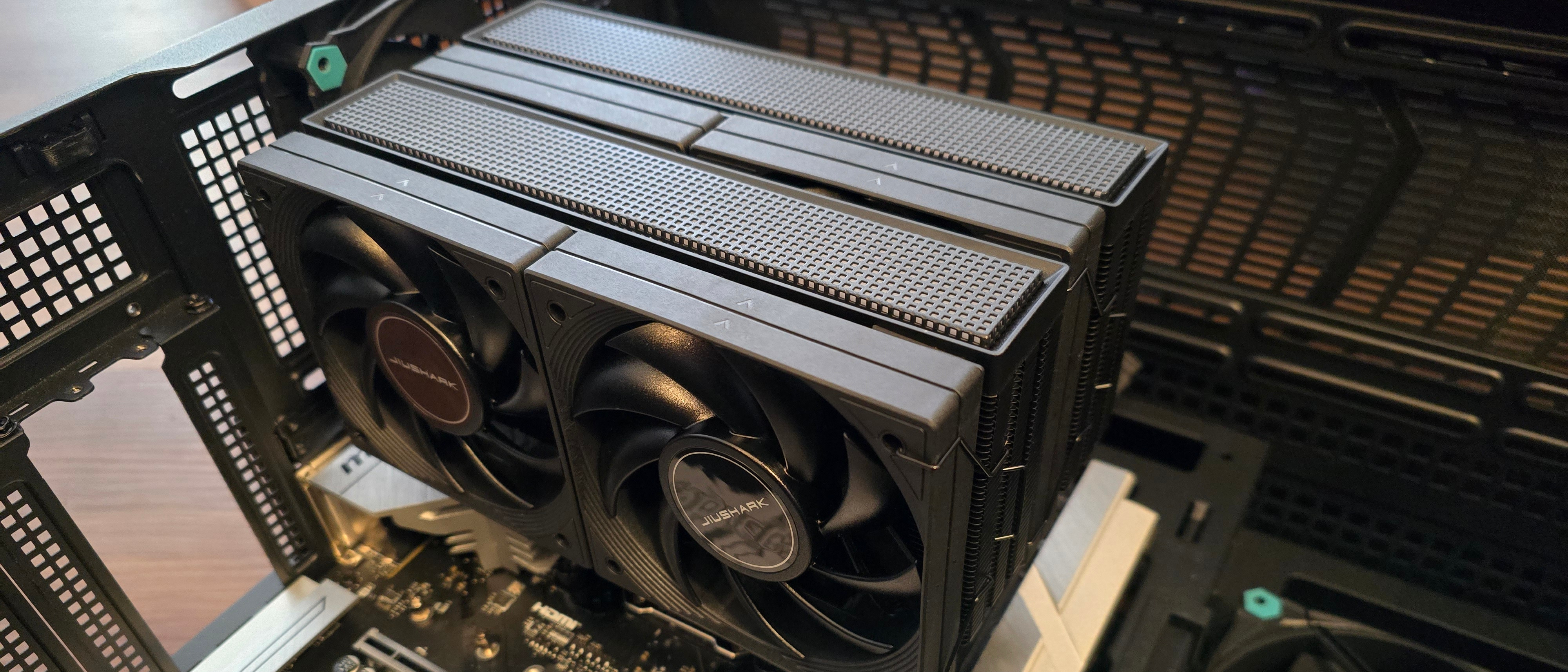Why you can trust Tom's Hardware
Maximum noise levels
For an air cooler, Jiushark’s design can get pretty noisy – reaching 47.2 dBA in our measurements. It’s the second loudest air cooler we’ve tested in recent history. Given its four smallish fans, perhaps that’s not so surprising.
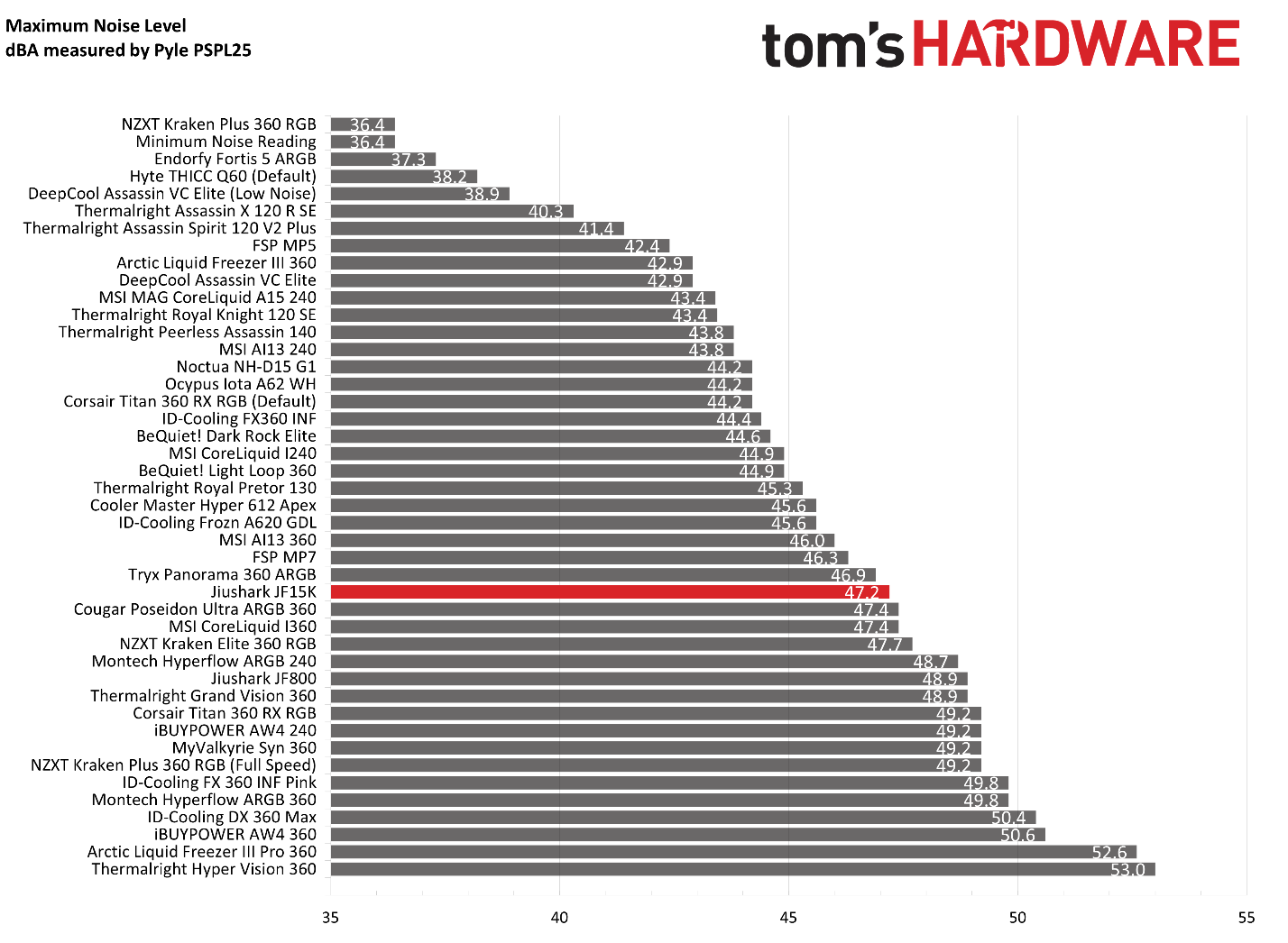
CPU-only thermal results with PBO enabled: AMD Ryzen 9 9950X3D
Without power limits enforced, the hottest CPUs on the market will hit their peak temperature (TJ Max) and thermally throttle with even the strongest of air coolers; even most liquid coolers available can’t keep these chips from throttling during intensive stress testing. For the best liquid coolers on the market, the results of this test will be shown using the CPU’s temperature. However, when the CPU reaches its peak temperature, I’ve measured the CPU package power to determine the maximum wattage cooled. Note that thermal performance can scale differently depending on the CPU it’s being tested with.
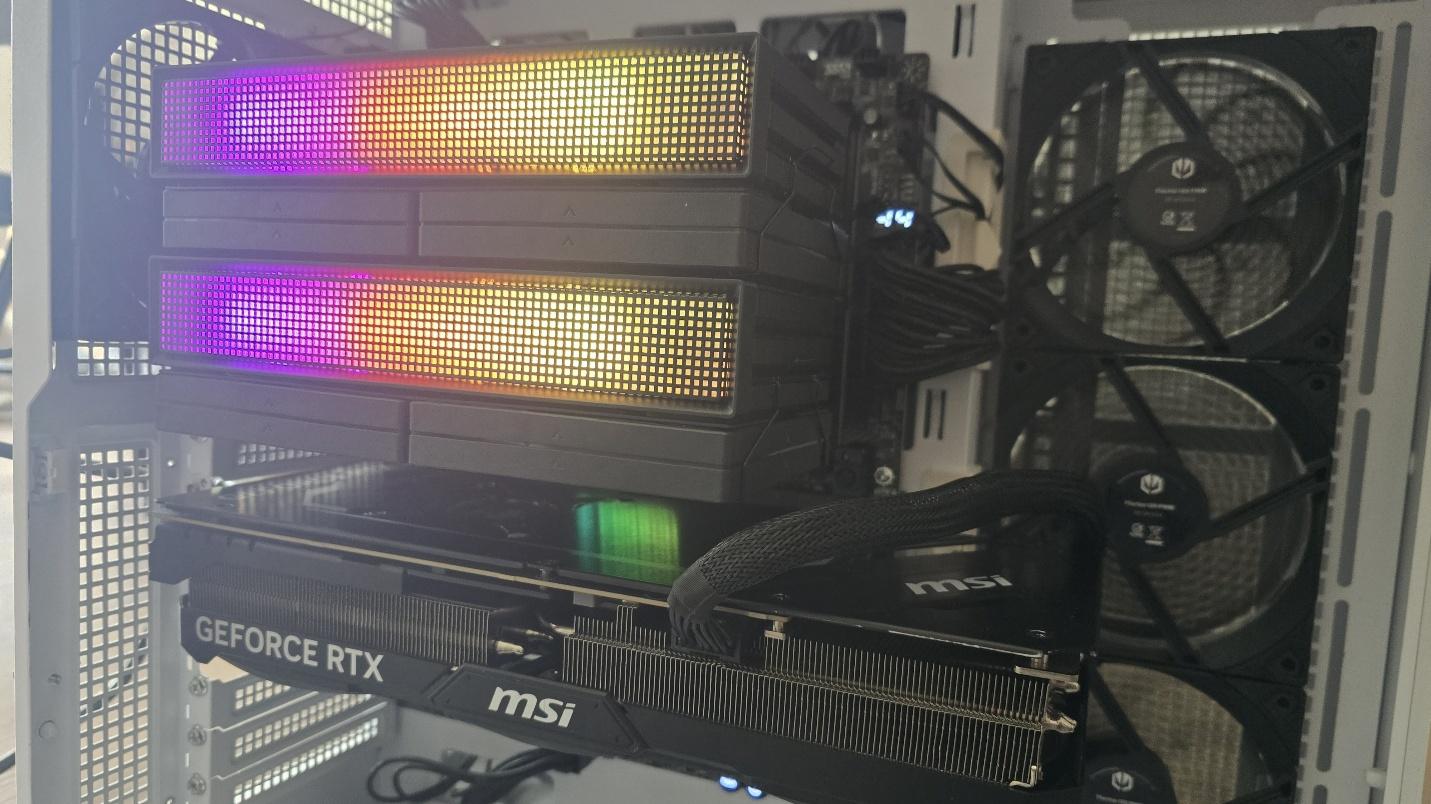
We’ll start by looking at the performance of this cooler with AMD’s gaming flagship, the Ryzen 9 9950X3D CPU.
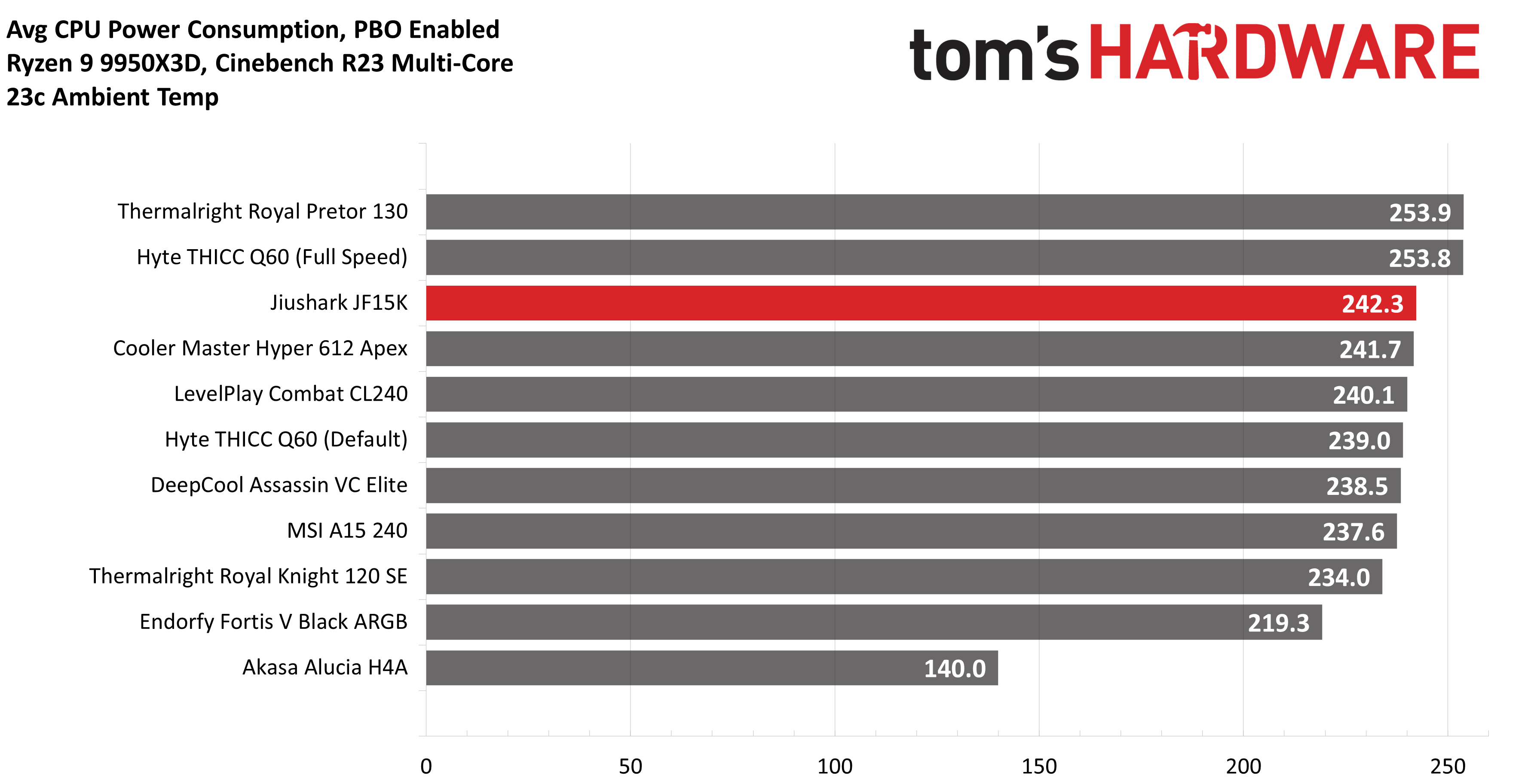
The strongest 360mm AIOs on the market can handle this workload without reaching the CPU’s peak temperature. With the disclaimer that we’ve only had a limited amount of time to test AMD’s Ryzen 9 9950X3D with coolers, only two AIOs have passed this test thus far: Arctic’s Liquid Freezer III Pro and NZXT’s Kraken Plus 360.
Performance here was fairly good, with Thermalright’s Royal Pretor 130 being the only air cooler to outperform Jiushark’s double-wide tower cooler!
CPU-only thermal results with power limits removed: Intel’s i7-14700K
Now let’s switch it up and take a look at how this cooler performs with Intel’s i7-14700K. We can see some coolers, including the JF15K here, seem to scale better with AMD Ryzen than they do with Intel Core CPUs.

Jiushark’s massive air cooler outperformed classics like Noctua’s NH-D15 (G1), but was outperformed by dual tower coolers from DeepCool, Thermalright, and even Jiushark’s own JF800.
Get Tom's Hardware's best news and in-depth reviews, straight to your inbox.
200W Power Limit – AMD Ryzen 9950X3D
My recent reviews have focused more on tests with both the CPU and GPU being stressed, but many of y’all have indicated that you would like to see more CPU-only tests. Listening to that feedback, I’ve tested thermal and noise performance for AMD’s Ryzen 9 9950X3D at stock CPU settings – which limits power consumption to 200W.
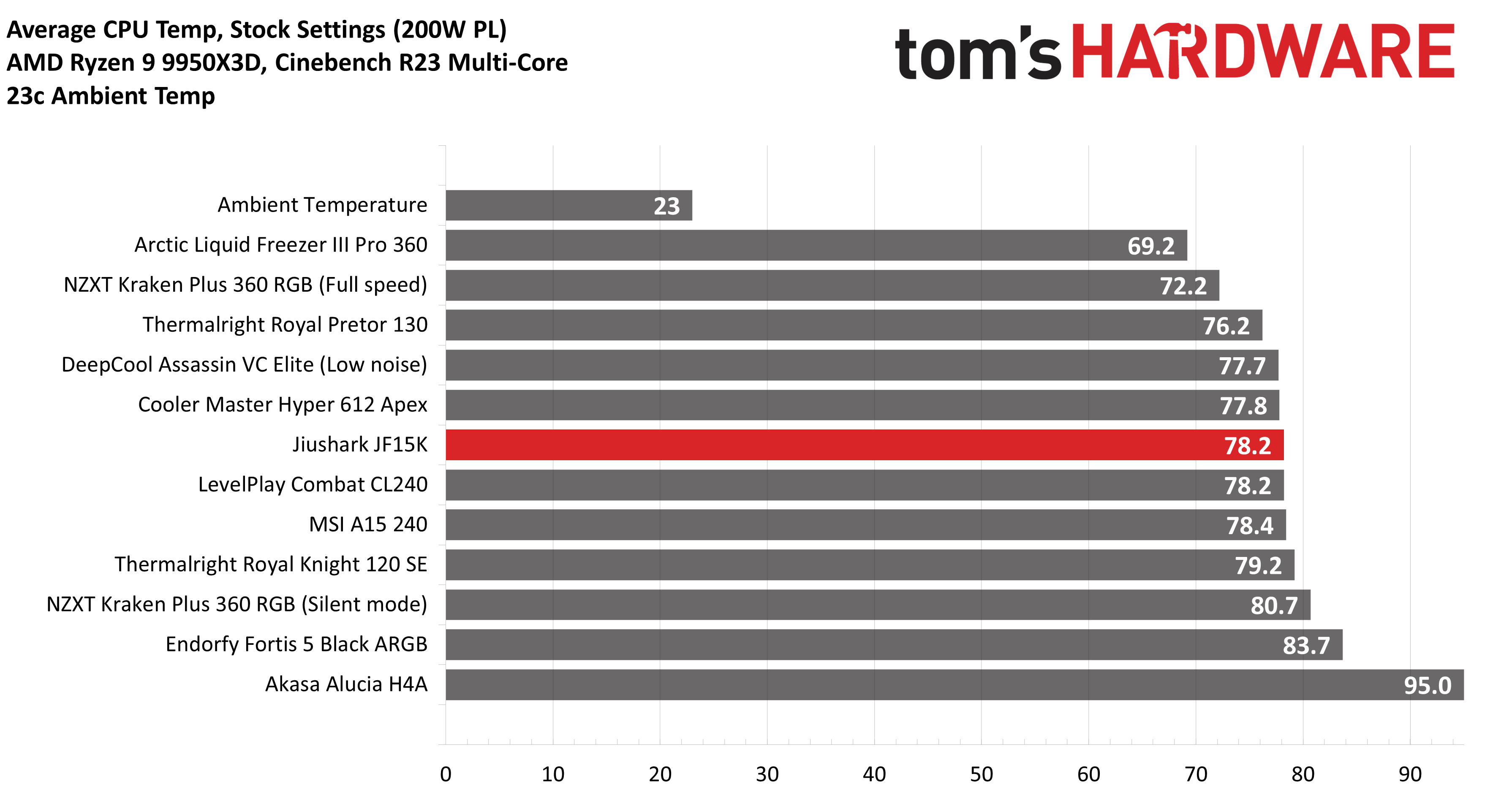
This test showed some interesting results. Jiushark’s JF15K performed a little bit behind Cooler Master’s Hyper 612 Apex and DeepCool’s Assassin VC Elite, but better than 240mm AIOs from LevelPlay and MSI, and single tower air coolers from Thermalright and Endorfy.
Noise levels weren’t quite as pleasant, though, averaging 46.9 dBA.
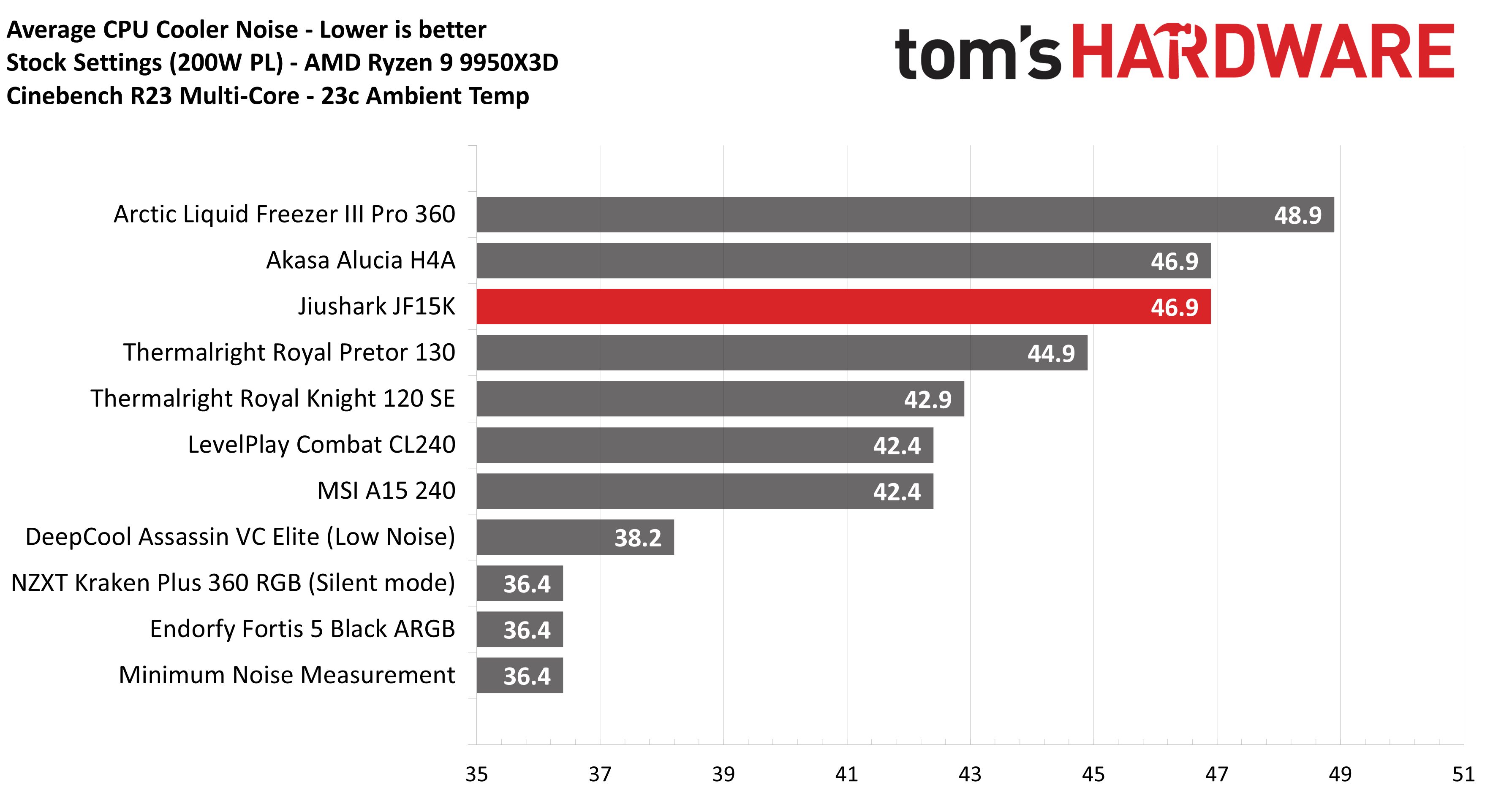
Noise-normalized CPU-only thermal results
Finding the right balance between fan noise levels and cooling performance is important. While running fans at full speed can improve cooling capacity to some extent, the benefits are limited, and many users prefer a quieter system. We’ll be looking at two different, distinct tests.
We’ll first look at our traditional noise-equalized results with Intel’s i7-14700K, which places a full CPU-only workload with the cooler’s noise levels set to 38.9 dBA. To make comparisons to other air coolers easier, we’ve removed AIO results from this chart.
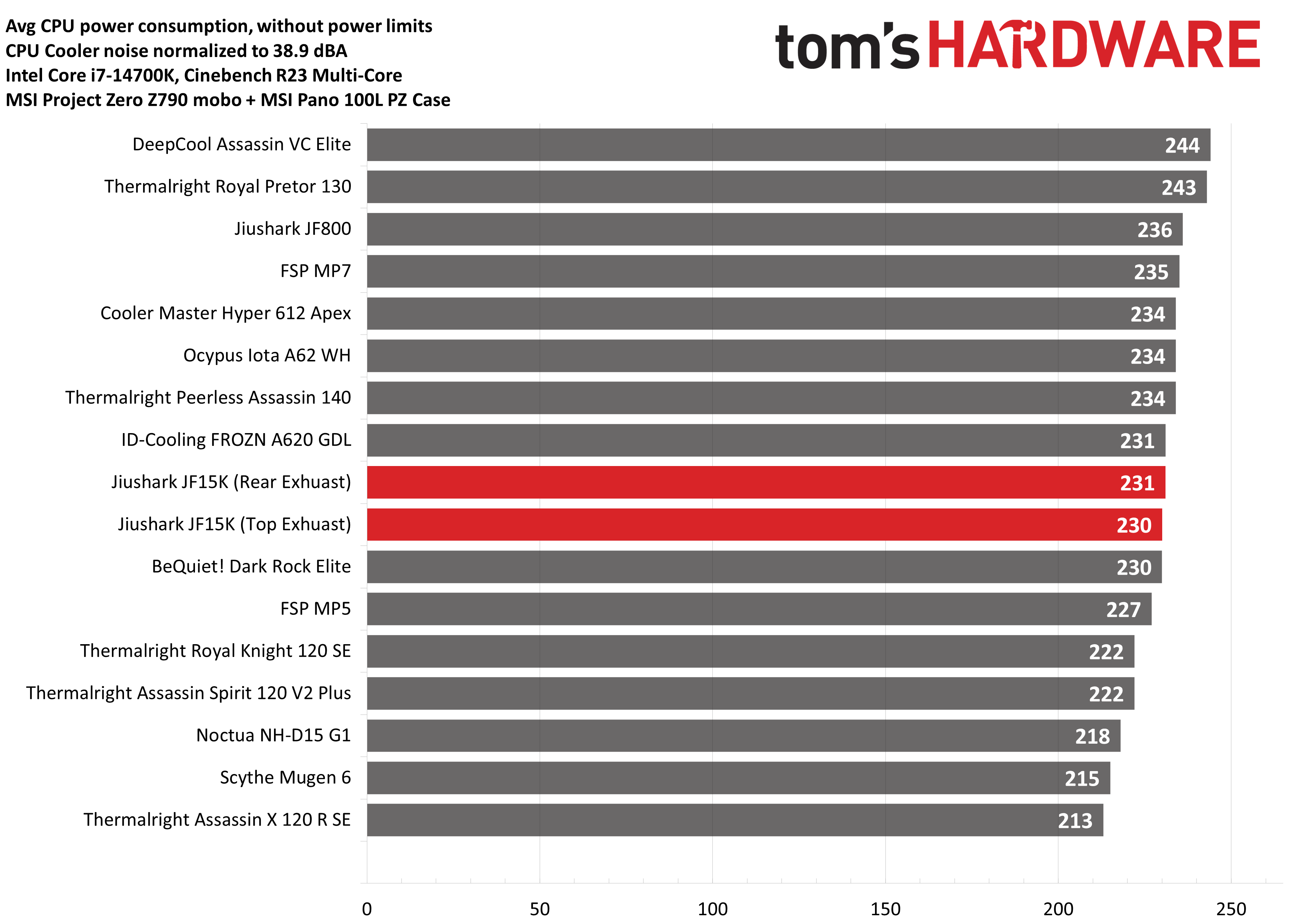
The first thing you might notice in this chart is that Jiushark’s JF15K is listed twice. This is because I wanted to see if moving the exhaust fan above the cooler would improve performance. But it didn’t seem to make much of a difference, with both results being within the general margin of error. With 231W cooled, performance here was similar to most traditional air coolers.
Now let’s take a look at our noise-equalized tests utilizing AMD’s Ryzen 9 9950X3D CPU. Two changes (in comparison to our first test) have been made to increase the difficulty of this challenge. The noise level of the CPU coolers has been reduced to 37.3 dBA, and I’ve also run a full load on MSI’s RTX 4070 Ti Super GPU at the same time to increase the difficulty of this benchmark.
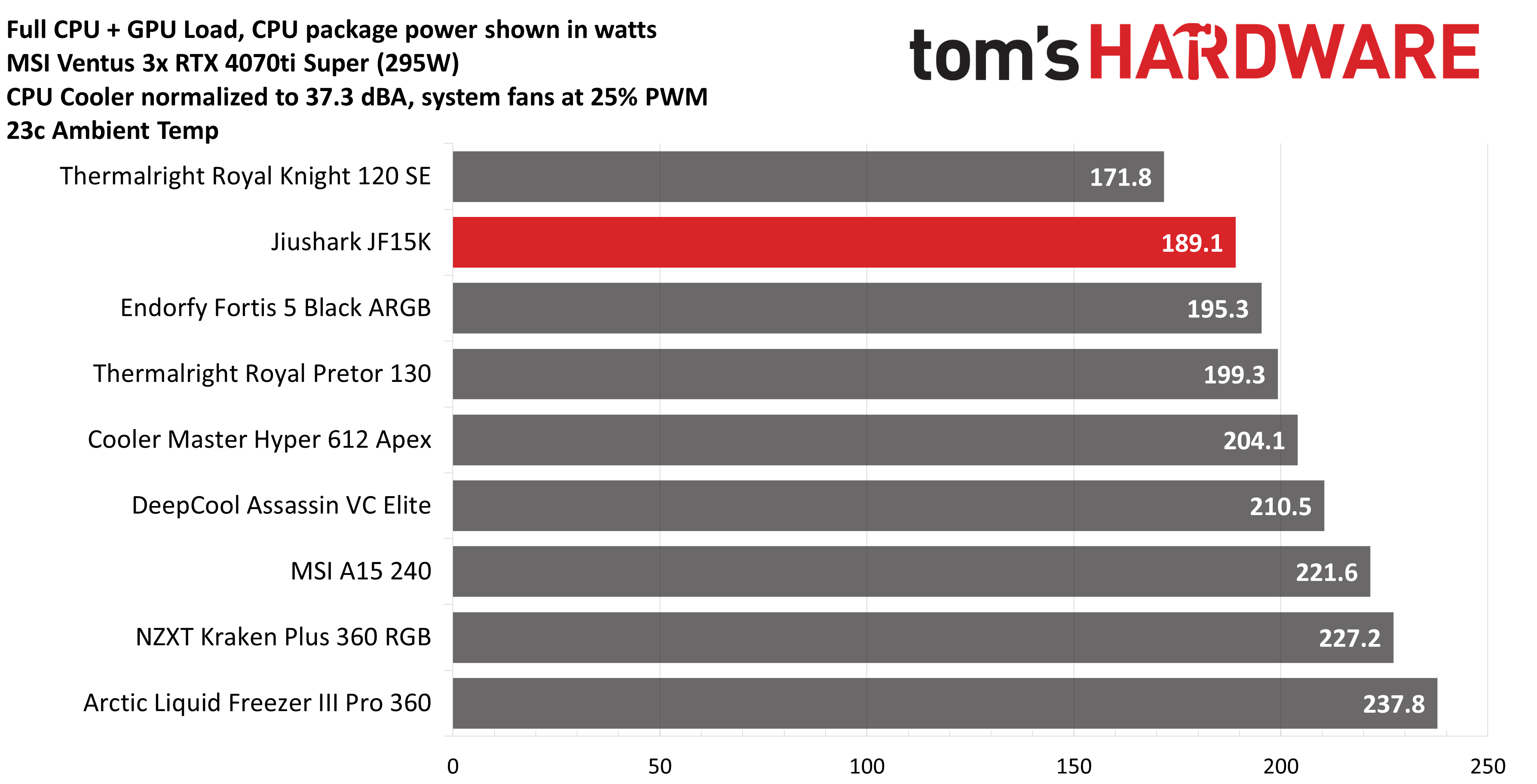
The JF15K wasn’t very impressive here, with only 189W cooled on average. This is the second-worst result we’ve seen in this low-noise, low case airflow test. It likely indicates that for best performance, you’d want this cooler installed in a case with good airflow.
150W CPU + 290W GPU results
Testing a CPU Cooler in isolation is great for synthetic benchmarks, but doesn’t tell the whole story of how it will perform. If your GPU is running a full load, that heat doesn’t just disappear – it makes it harder for your CPU cooler to do its job due to the increased heat within your computer case.
The CPU power limit of 150W was chosen based on the worst CPU power consumption I’ve seen reported in gaming amongst various tech outlets covering AMD’s Ryzen 9 9950X3D. My personal experience has shown most games to use much lower amounts of power, but this might be biased by the games I play.
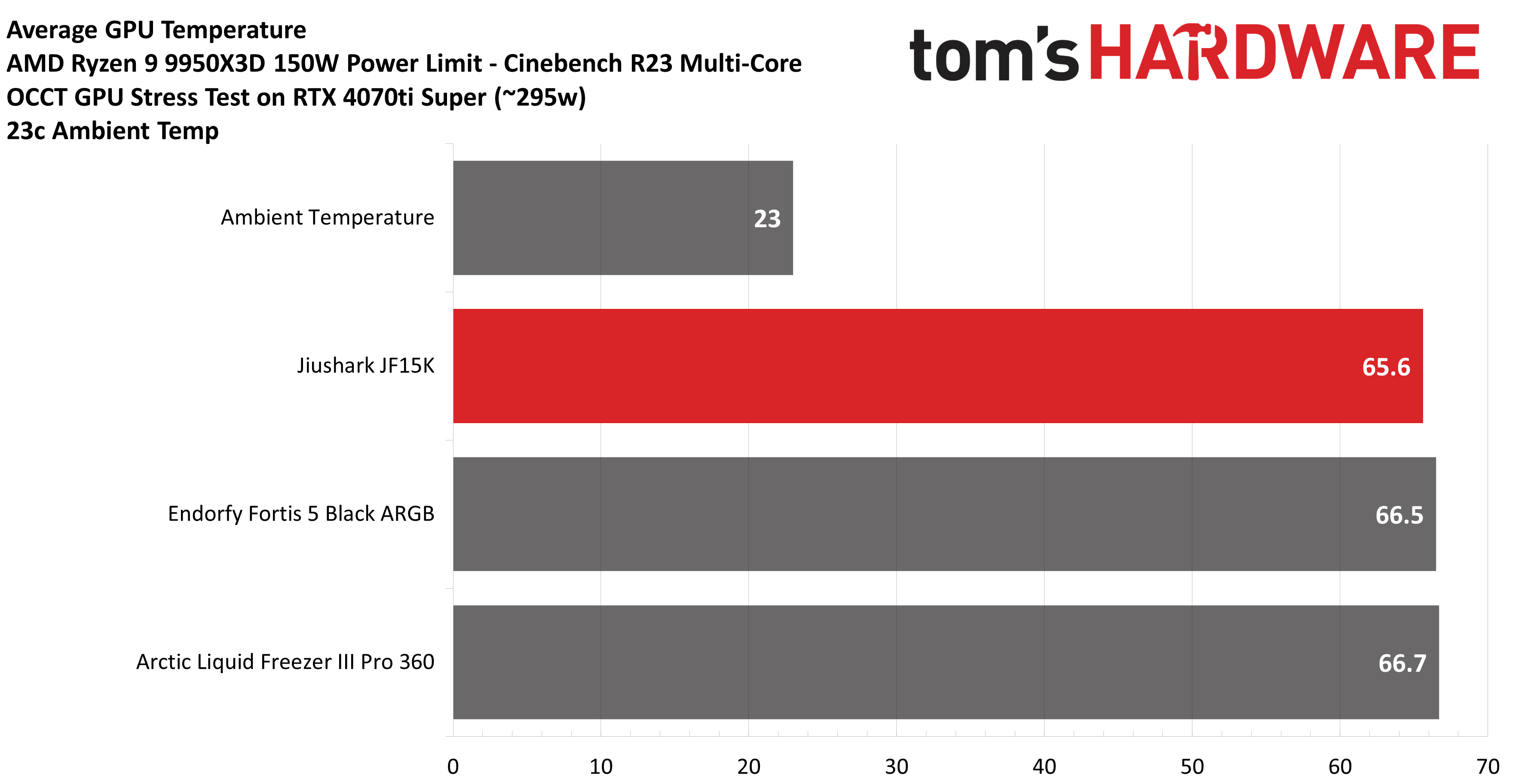
Looking at the unique design of Jiushark’s JF15K, I figured that it might help with the temperatures of the GPU in this scenario. The data I have shows better GPU temperatures than both Endorfy’s Fortis 5 Black and Arctic’s Liquid Freezer III Pro in this test. This might mean that the JF15K could be useful in smaller cases that don’t have much room for airflow. But given the cooler’s size, it’s realistically not going to fit in cases that are all that small.
If you’re wondering why we have only three results above, the simple answer is I didn’t think I would be comparing GPU temperatures for a CPU cooler review, and as such, I usually didn’t save this information when testing coolers previously.
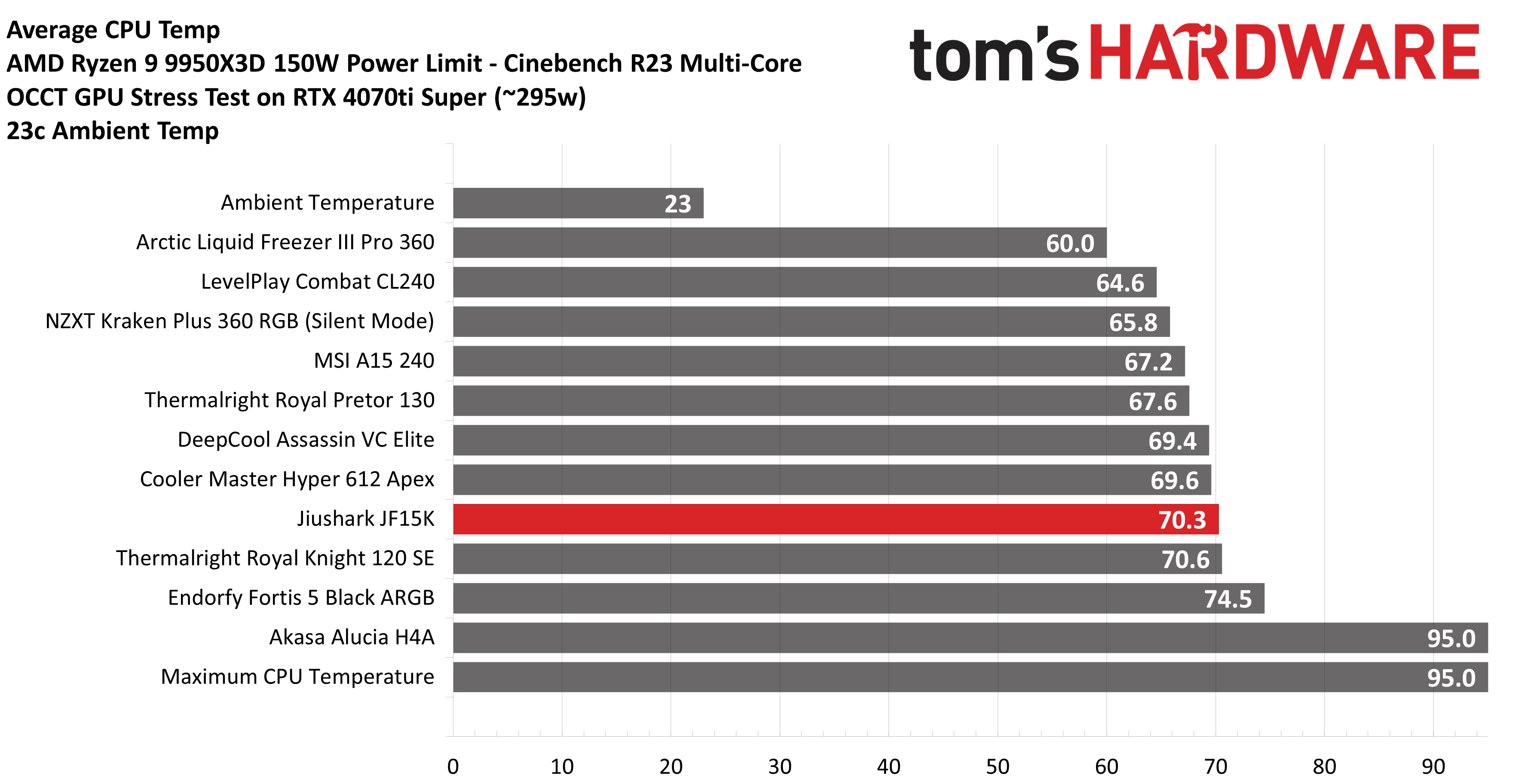
Looking at CPU temperatures, Jiushark’s JF15K performed reasonably compared to traditional dual-tower air coolers, just a hair behind Cooler Master’s Hyper 612 Apex and DeepCool’s Assassin VC Elite.
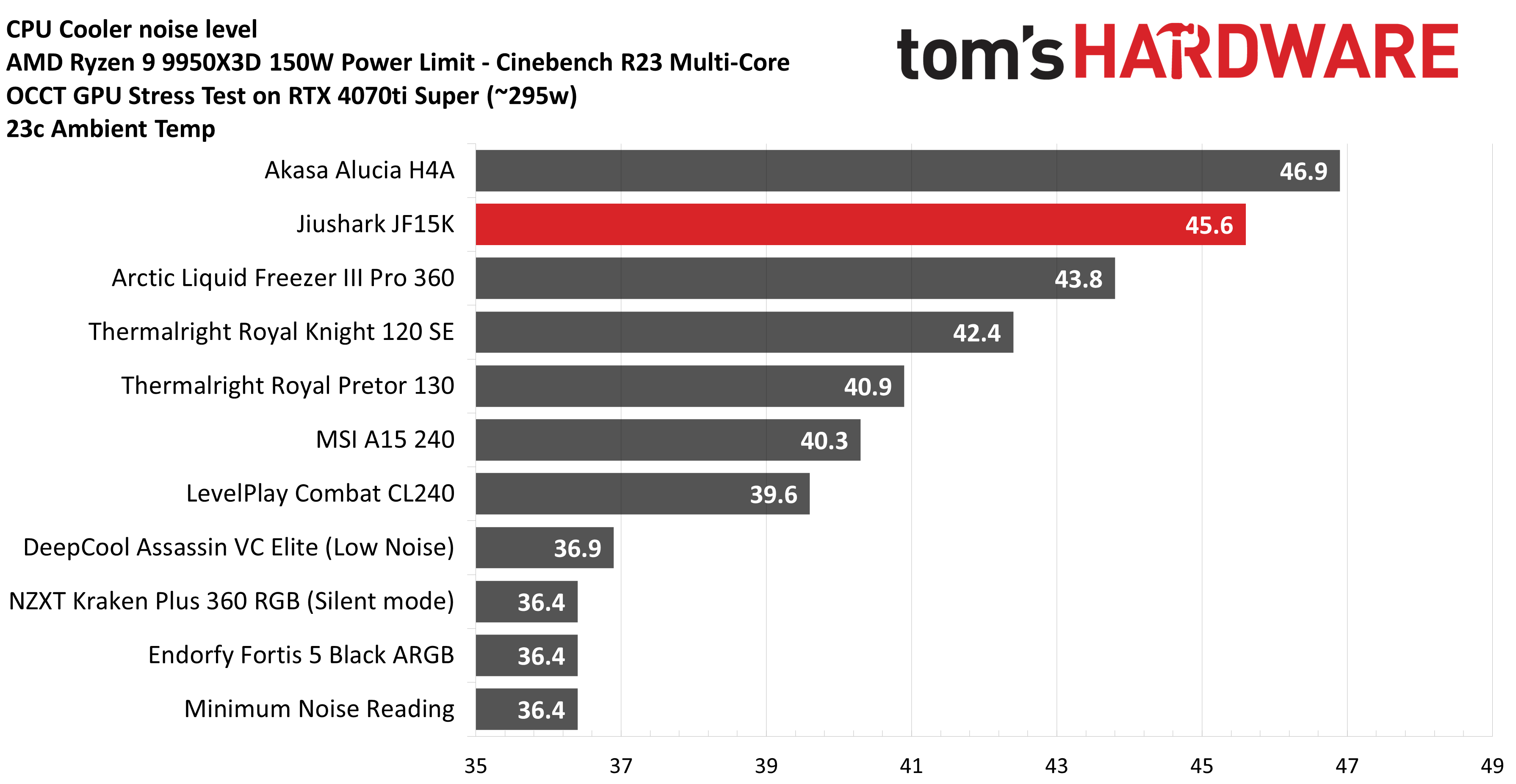
That said, noise levels were again louder than most coolers that we’ve tested with AMD’s Ryzen 9 9950X3D.
140W CPU results
The last round of test results we’ll look at in today’s review is a test with a 140W power limit imposed. This level of power is dramatically easier to handle for most coolers – and as a result, this is the easiest test we’ll run with AMD’s Ryzen 9 9950X3D CPU for most reviews.
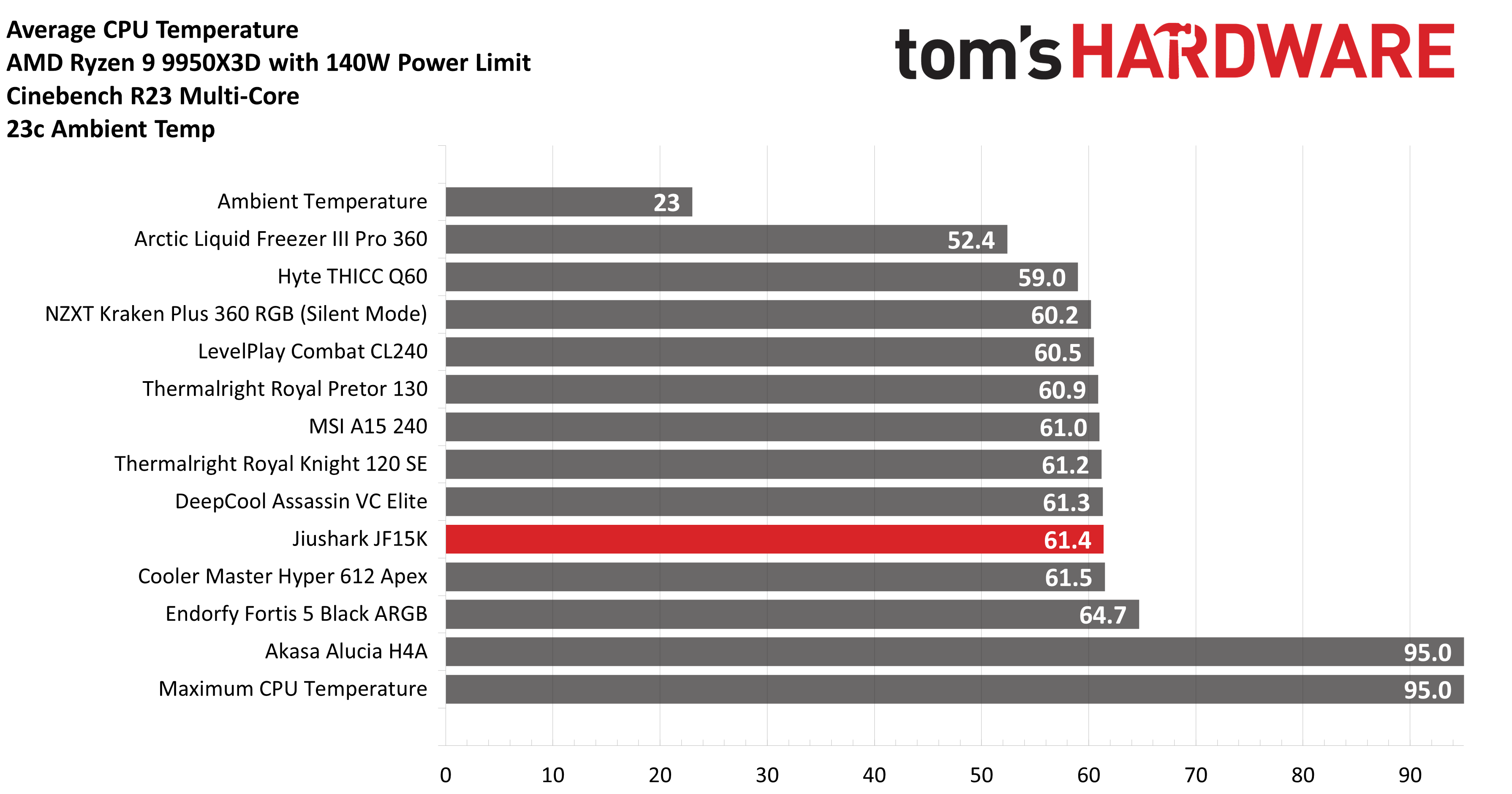
In this test, most of our coolers have similar performance. The more important factor in this test is the noise level of the cooler – and while the JF15K wasn’t exactly loud, it was among the noisiest results we have for this benchmark.
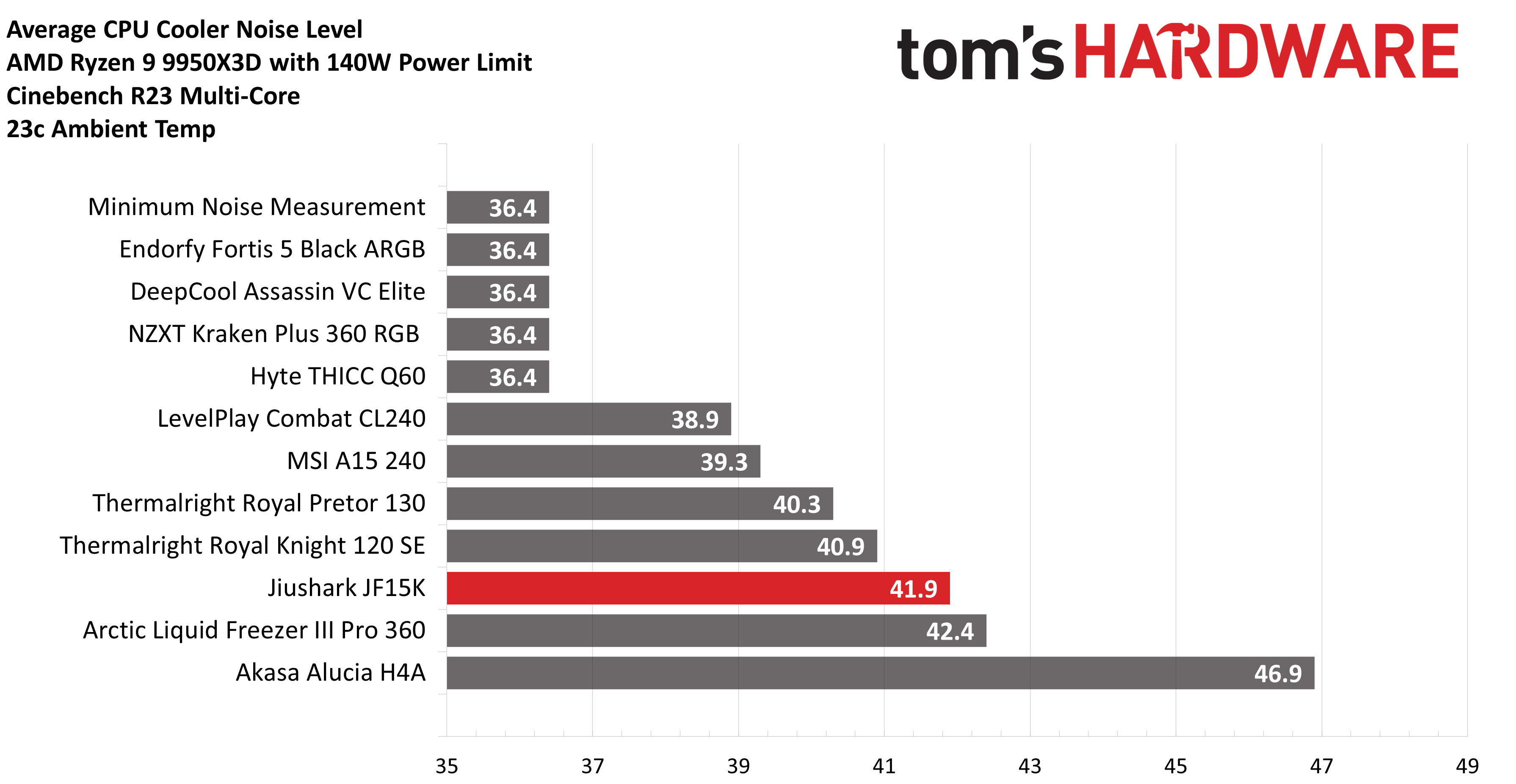
But wait, there’s more!
There’s an additional advantage that this cooler provides, that I haven’t tested in detail – it provides airflow over RAM, having two fans directly above the DIMM slots of the motherboard. This might prove useful for those looking to run the fastest memory kits and/or those who wish to overclock their RAM.
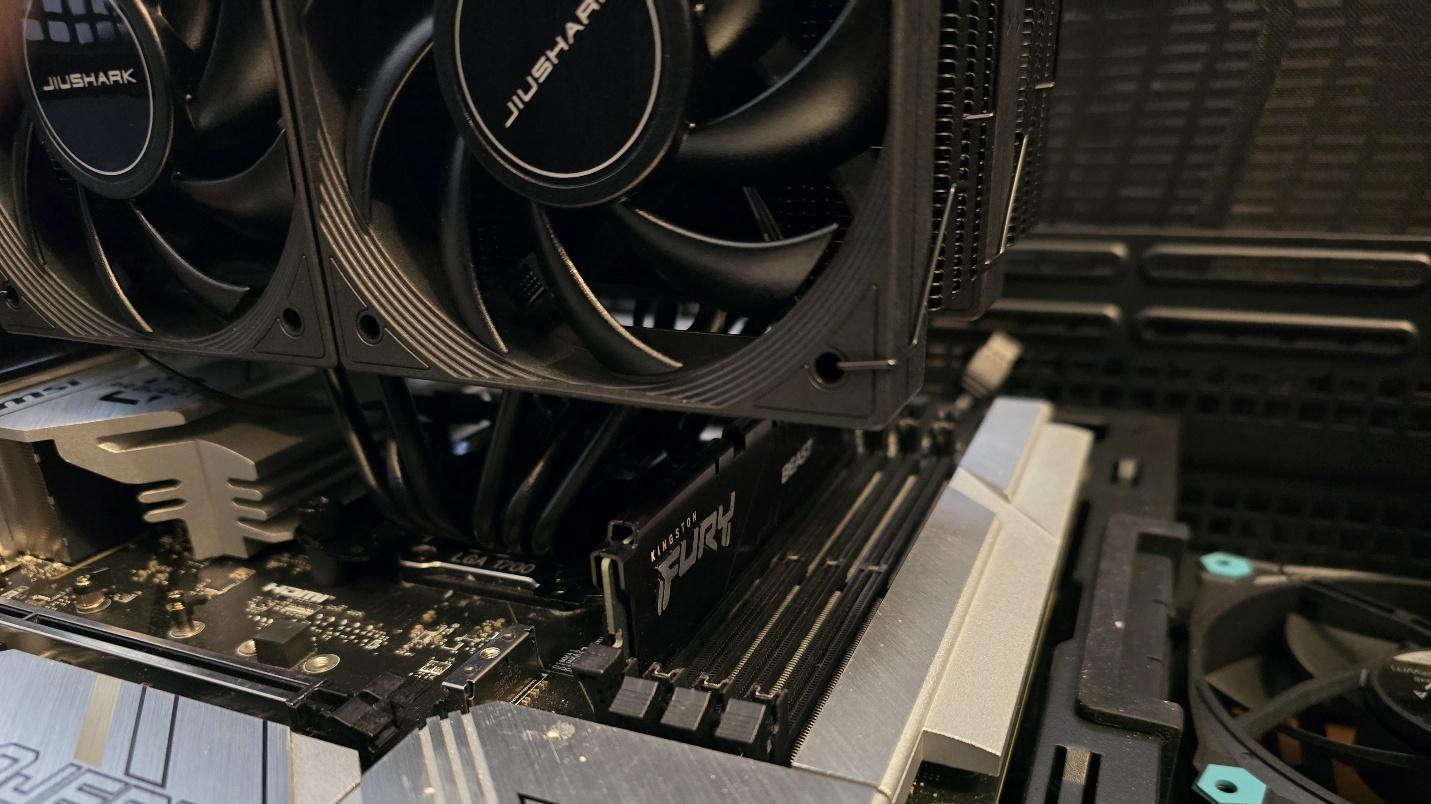
Conclusion
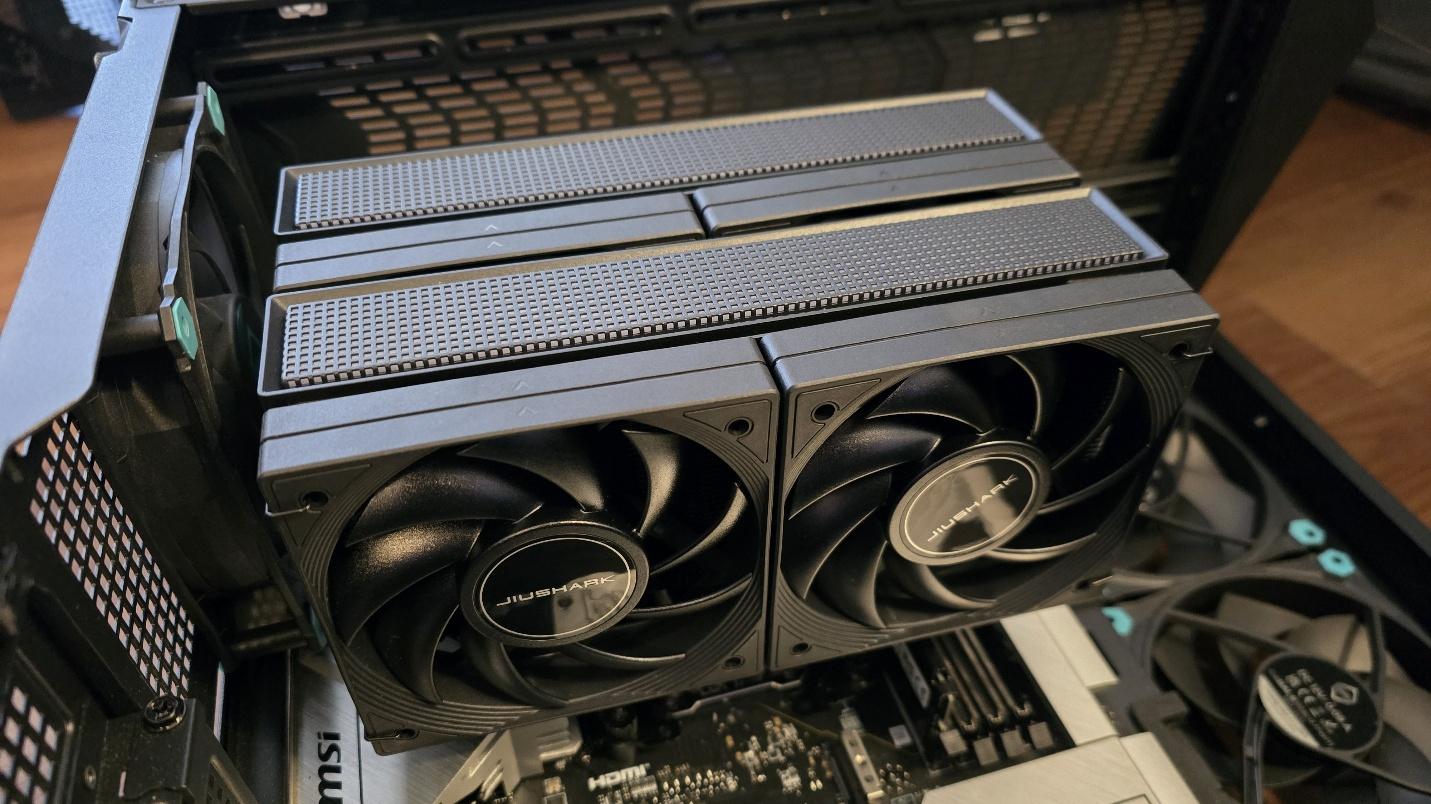
Jiushark’s innovative double-wide dual-tower air cooler is an interesting engineering experiment, providing particularly impressive results in some scenarios, but that is balanced by other situations where it performs worse than expected.
The fans above RAM slots may prove useful for those looking to run the fastest memory speeds and/or overclock their DDR5. I’d like to see a version of this cooler produced with more heatpipes (or thicker ones), and perhaps stronger fans that aren’t as noisy.

Albert Thomas is a contributor for Tom’s Hardware, primarily covering CPU cooling reviews.
-
Dementoss I see it blocks the rear exhaust fan and, it's own intake fans are very close to the back of the graphics card. Not surprising performance is underwhelming in some situations, seems a poorly thought-out design.Reply -
bit_user Reply
The article mentions this three times. Would've been really nice to see any kind of temperature data on it, especially since I don't see where it directs airflow down onto the DIMMs. Running airflow parallel to them doesn't seem like it would provide much benefit, but stirring up air in that part of the case might.The article said:There’s an additional advantage that this cooler provides, that I haven’t tested in detail – it provides airflow over RAM, having two fans directly above the DIMM slots of the motherboard. This might prove useful for those looking to run the fastest memory kits and/or those who wish to overclock their RAM.
Also, I don't see anywhere the article doesn't specifies its weight. At this end of the scale, I think that's probably a significant consideration for some. Here's the manufacturer's product page, but I don't see where it tells us and it doesn't help that Google Translate seems to choke on it:
https://www.jiushark.com/en/products/jf15k.html -
bit_user Reply
Thank you! I was trying to remember what that was called.tennis2 said:Looks awful similar to the IceGiant ProSiphon.
Toms reviewed the Ice Giant Prosiphon Elite, back in 2021:
https://www.tomshardware.com/reviews/ice-giant-prosiphon-elite-review -
tennis2 Reply
Ultimately not at any risk of patent infringement since the Jiushark is really just a "standard" heatpipe cooler. But the form factor isn't as unique as the article suggests.bit_user said:Thank you! I was trying to remember what that was called -
thestryker Reply
There's a graphic on that page which says 1350g so I assume that should be the weight with fans.bit_user said:Also, I don't see anywhere the article doesn't specifies its weight. At this end of the scale, I think that's probably a significant consideration for some. -
thestryker Due to pass through design on basically everything 30 series/RDNA 2.0 on coolers like this are at a disadvantage. It would require very high airflow to move the heat away from the video card without soaking the CPU cooler.Reply
I think the design is interesting, but would really need to see it tested with exhaust fans in the top to see if that would fix the problem of heat soak. I don't think it would at a palatable noise level. I think it would probably need an offset tower to give more space between video card and cooler and fans capable of higher airflow through the fins. -
tamalero Reply
Exactly what I was going to say lmao.tennis2 said:Looks awful similar to the IceGiant ProSiphon.
Looks like a blatant copy design wise. -
dwd999 One important spec that I noticed on their website and don't remember seeing in the article is that the clearance over the ram dimms is 48mm, which is higher than most led rams (e.g. mine are 44mm).Reply -
BillyBuerger Nice timing, I was just thinking a double-wide tower heatsink would work well for my situation and I could have sworn I'd seen at least one before. The Ice Giant may have been it but I also feel like going back even further there was some 2x 80mm fan thing like this. But I could just be remembering wrong. The smaller size of the Jiushark is nice but it's centered unlike the Ice Giant which is offset to one side a bit.Reply
